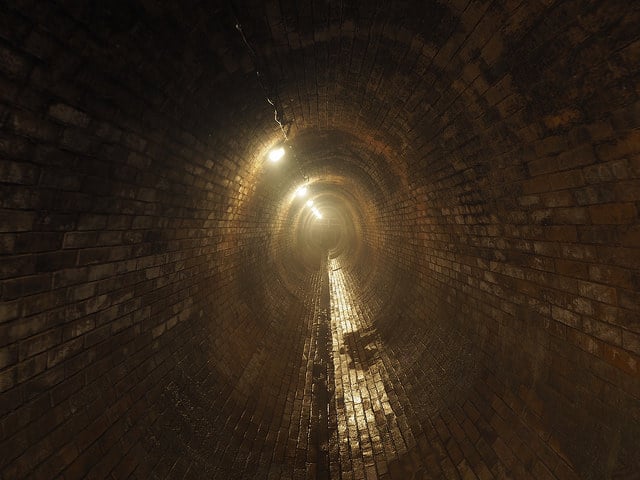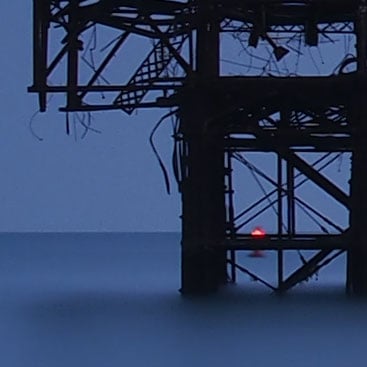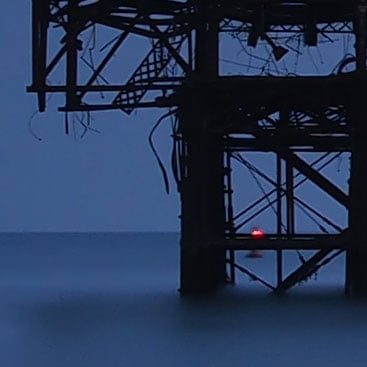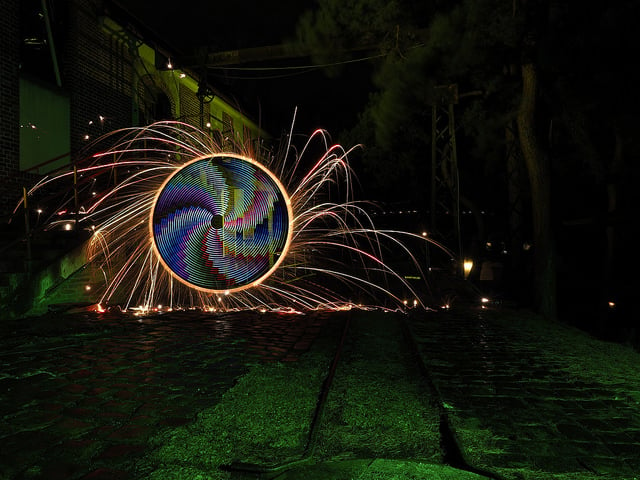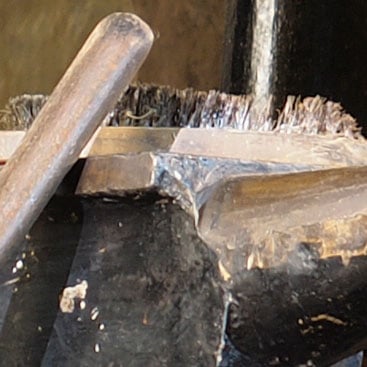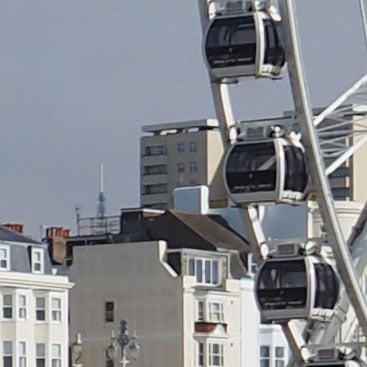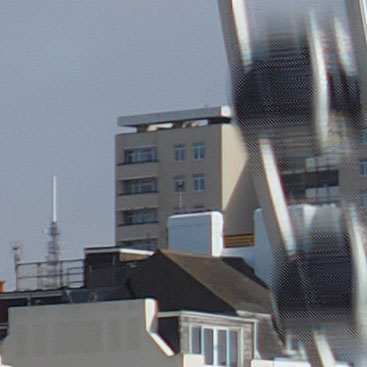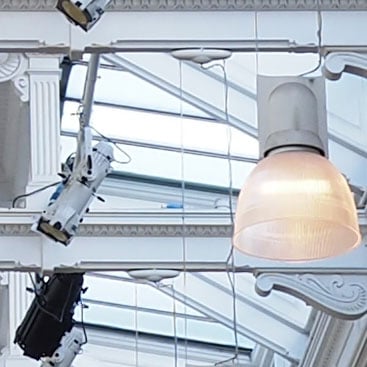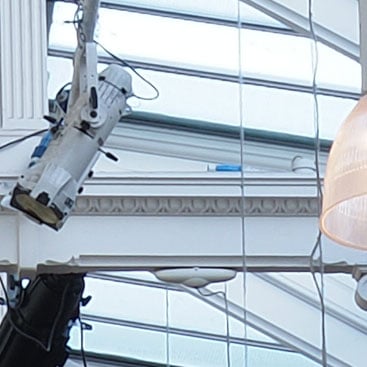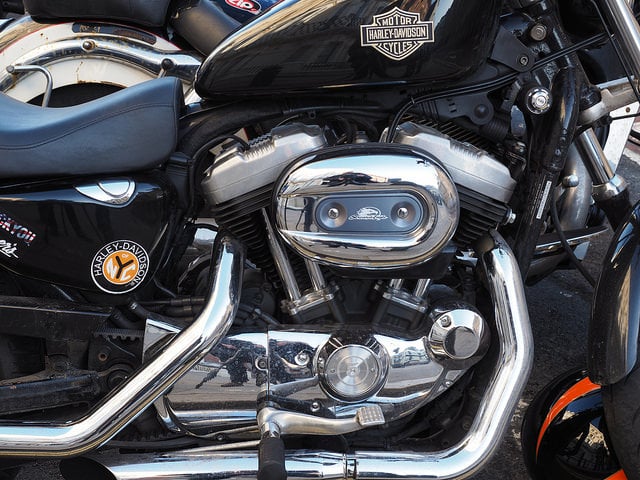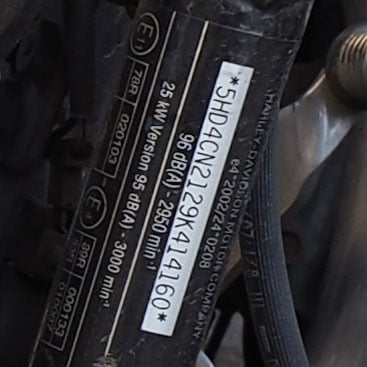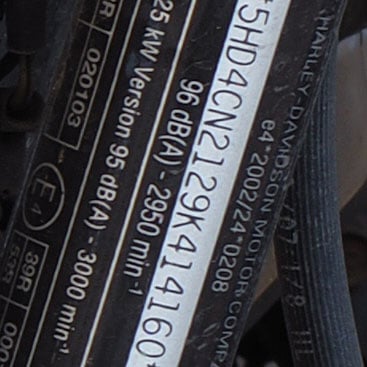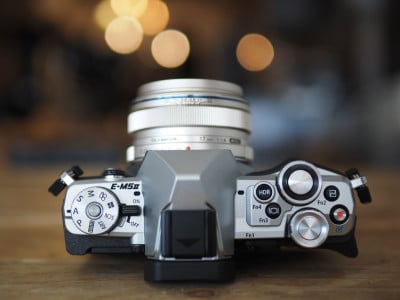Olympus OMD EM5 Mark II review
-
-
Written by Gordon Laing
In depth
The Olympus OMD EM5 Mark II is a compact mirrorless camera aimed at enthusiasts. Announced in February 2015, it’s the successor to the original OMD EM5 and becomes the fourth model in the OMD series; like all the OMD cameras it’s based on the established Micro Four Thirds standard, providing access to the broadest range of native lenses of any mirrorless system, and like previous OMDs features an electronic viewfinder and built-in stabilization that works with any lens you attach.
Externally the EM5 Mark II shares a great deal with its predecessor with a compact, tough and weather-proof body, but it’s now additionally tested to be freeze-proof. Fans of the higher-end OMD EM1 will be pleased to find a redesigned grip, chunkier control dials and buttons, along with a PC Sync port for connecting to external lighting. Indeed the EM5 Mark II shares a great deal with the EM1, inheriting its excellent XGA OLED viewfinder, 1/8000 shutter and built-in Wifi.
Olympus has improved the response time of the five-axis stabilization system, now claiming five stops versus four on the EM5 and EM1. The movie mode is greatly enhanced with a fully-articulated screen, the choice of 24, 25, 30, 50 or 60p frame rates, 77Mbit/s encoding, support for focus peaking while filming, touch-control of settings and a headphone socket on the optional mini-grip. The mechanical shutter is now much quieter, and for complete silence there’s an electronic shutter option up to 1/16000. Arguably most exciting of all though is the new High Res mode that shifts the sensor slightly over eight shots to generate a single 40 Megapixel image, finally breaking the 16 Megapixel ceiling of Micro Four Thirds, at least for static subjects. It all adds up to one of the most compelling mirrorless cameras to date, so read on to discover if it delivers the goods in practice!
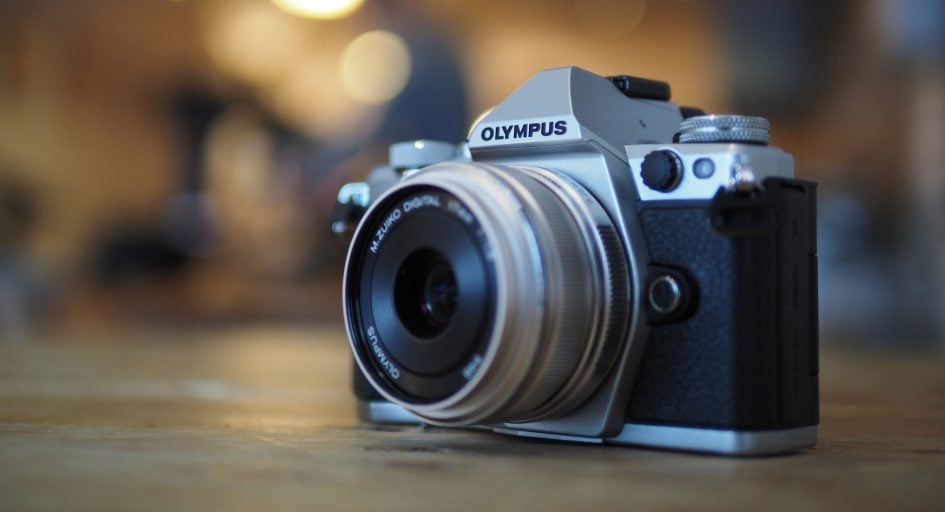
Olympus OMD EM5 Mark II design and controls
The EM5 Mark II looks a lot like its predecessor, but feels quite different in your hands. The redesigned front grip curves inwards to meet your middle finger, offering a surprisingly effective boost in purchase. The twin control dials have also been thickened and repositioned, allowing you to easily turn either even when holding the camera one-handed (something that’s also practical given the improved stabilization). The shift of the thumb dial above the thumb rest follows the EM1’s approach and just feels so much better than the original EM5.
The Mark II also swaps the tiny spongey rear buttons of its predecessor with much more tactile and clicky versions which, while not as large as those on the EM1, are again a big step-up from the EM5. It’s these small improvements to ergonomics which make a big difference in day-to-day use. For me the redesigned controls on the EM1 were a triumph over the original EM5, and now the EM5 Mark II enjoys a similar boost in usability and handling. Below you can see the EM5 Mark II on the left and the original EM5 on the right; both cameras are available in black or silver, which do you prefer?
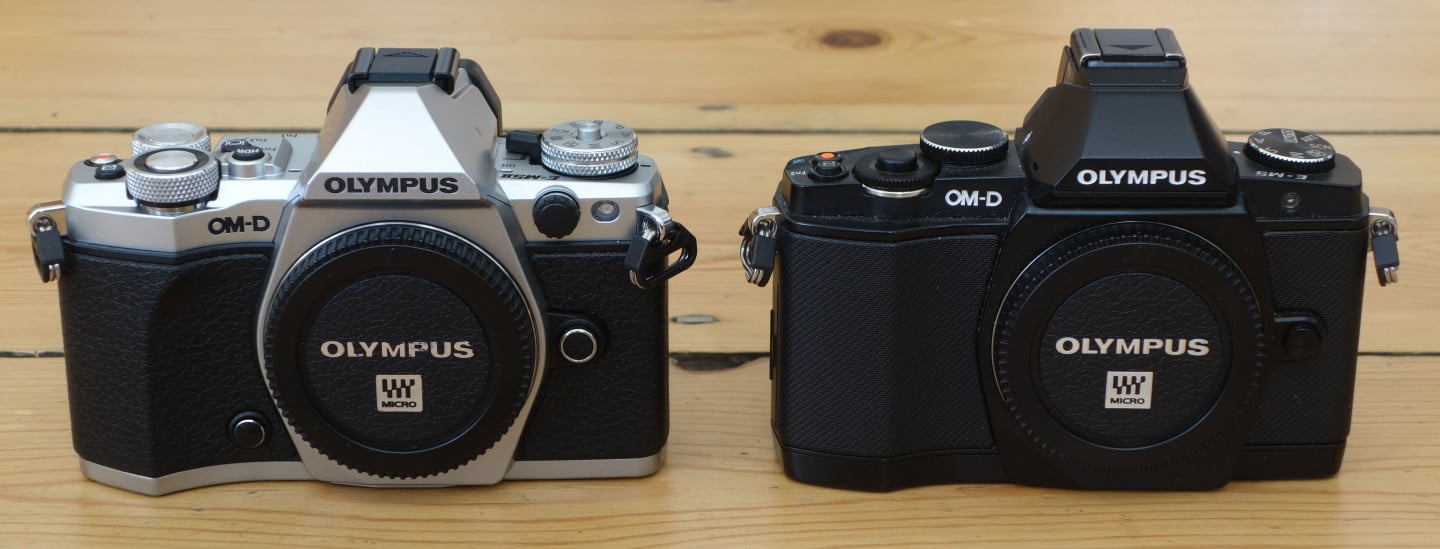
I was also impressed to find the EM5 Mark II inheriting the ‘2×2’ lever of the EM1, positioned to the right of the viewfinder. This allows you to assign two different functions to each control dial and quickly switch between them. By default, the two wheels adjust the aperture or shutter in their respective priority modes along with exposure compensation, but by flicking the switch they change their function to adjust, say, the ISO or White Balance instead. Then once you’re done, just flick the switch back to adjust the exposure again. It’s a novel approach which maximises the use of the dials and eliminates the need to push buttons or navigate menus for your most-used settings.Indeed it’s only when you have the EM5 Mark I and Mark II next to each other that you notice exactly how much Olympus has changed. You already know about the thicker finger and thumb wheels, but the mode dial on the upper left side of the body has also been thickened and gains the useful locking button of the EM1, which satisfyingly feels like operating a ballpoint pen. The Mark II also dispenses with the small power lever in the lower right corner of the back and switches it for a larger EM1-style switch on the top left of the upper panel; it’s in the same place as the EM1, but around the mode dial rather than the EM1’s additional buttons.
The Mark II also squeezes more buttons around its body and in true Olympus style everything is customisable. That said I’m pretty happy with the default configuration where the White Balance and ISO are accessible via the main dials with a flick of the 2×2 lever, and the four cross keys directly adjust the AF area (although you can also simply touch the screen to reposition it). I think the only thing I’d reconfigure is the Fn4 button which sets the HDR mode by default, but I’d more frequently access the drive mode settings, particularly the self-timer. If you regularly use non-native manual focus lenses, you may also want to assign focus peaking to one of the buttons as it won’t activate automatically.
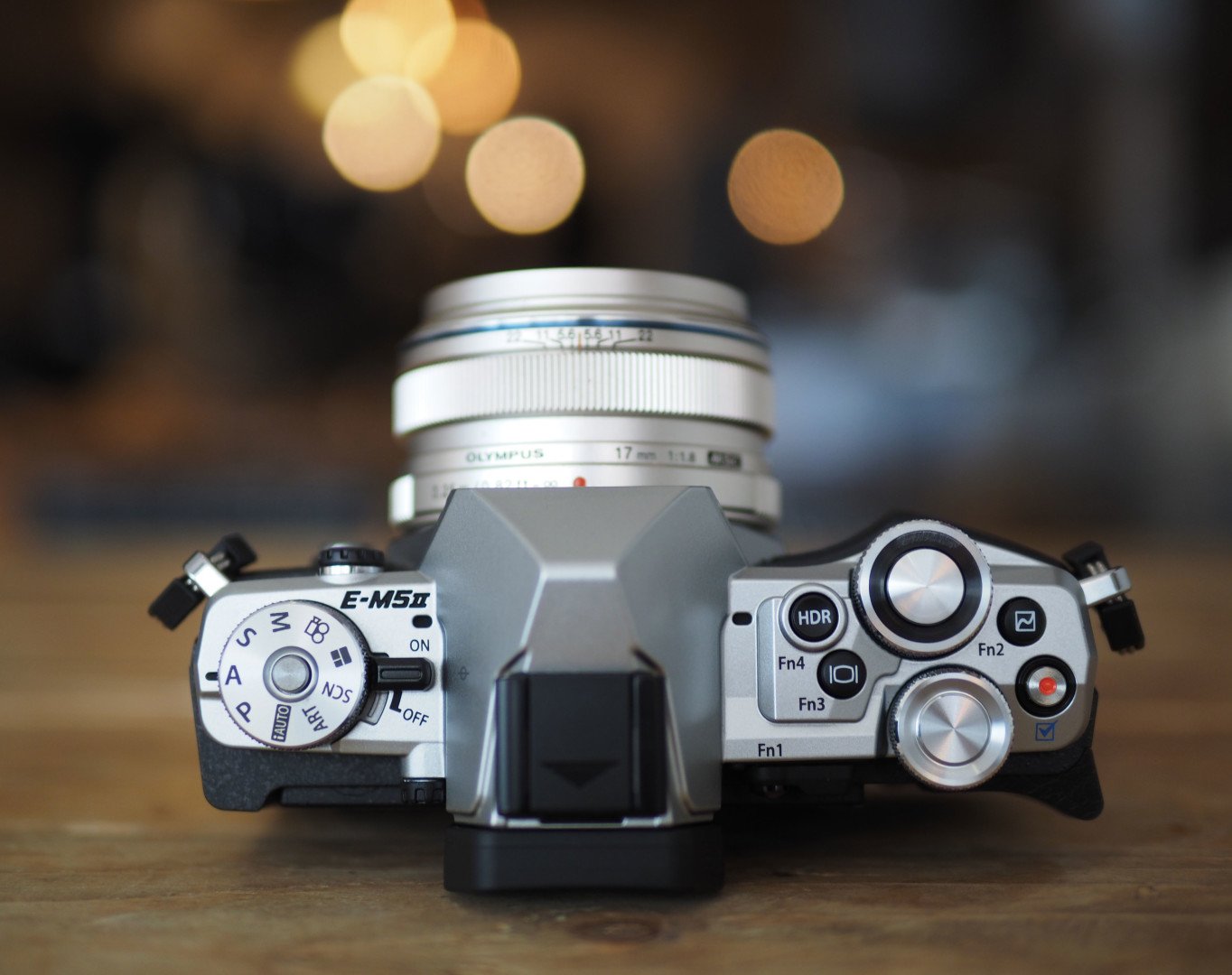
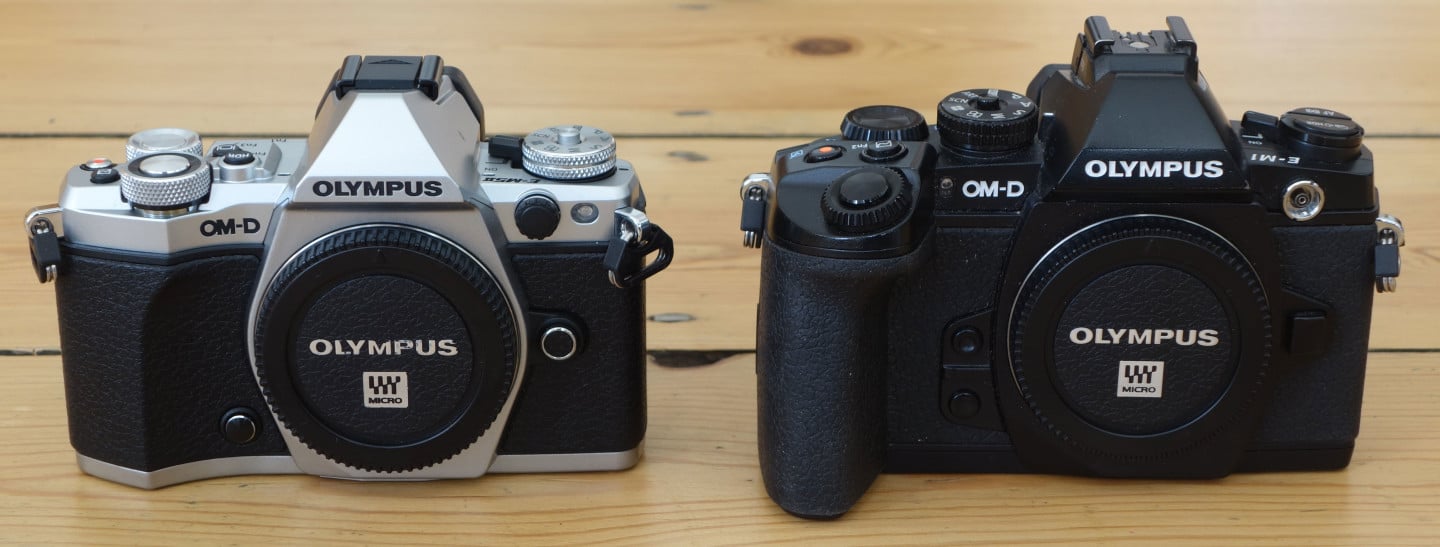
As you customise the buttons, it’s easy to forget the EM5 Mark II also offers two very usable on-screen menu systems when you press the OK button: the simple Live Control and more sophisticated Live SCP (Super Control Panel), the latter now sensibly set as the default for PASM modes. Live Control super-imposes a scrolling column of settings on the right side of the screen with the relevant options shown in a bar along the bottom; this interface is navigated using the cross keys. Meanwhile the Super Control Panel takes over most of the screen, presenting various options in a grid which you can navigate by touch or using the cross keys. Having the Super Control Panel on the main screen is a great complement to composing with the viewfinder, and, unlike the EM1, I’m pleased to report you can tap the SCP options without having to press OK first. Again the little things that make a big difference.Looking at the dimensions, the Mark II, at 124x85x45mm is a little wider and thicker than its predecessor, but a bit shorter, and only a tad heavier at 469g compared to 425g (both with battery). For the record, the flagship EM1 measures 130x94x63mm, making it larger in every dimension, and at 496g with battery, a tad heavier too. In your hands, the biggest difference with the EM1 is its grip that’s noticeably taller and deeper than the two EM5s. There’s more to wrap your fingers around on the EM1 as standard and the taller height means those with smaller hands won’t leave any digits dangling. In contrast most hands will have a small gap somewhere when gripping the EM5 Mark II, and most little fingers will also be left dangling. Below you can see the EM5 Mark II on the left and the EM1 on the right; again, both cameras are available in black or silver.
But the EM5 Mark II has a solution for those who want more to hold onto. Like the EM5 before it, there’s an innovative optional grip sold in two halves. The HLD-8G boosts the grip, gives your little finger something to hold onto, and provides a duplicate shutter release and front dial, positioned forwards for greater comfort. In a nice upgrade, the HLD-8G also offers a new headphone jack for monitoring movie audio.
Then if you want additional power and portrait controls, you add the second half of the unit, the HLD-8, which accommodates a spare battery. While the HLD-8G is a new accessory that’s unique to the EM5 Mark II, the HLD-8 section is the same as the EM5, so owners of that part can re-use it on the Mark II, so long as they buy the HLD-8G of course.
New to the EM5 Mark II is the optional ECG-2 metal handgrip L-bracket which provides an Arca Swiss dovetail base – great for mounting the camera in the portrait orientation directly over a tripod head – although I wonder if the HLD-8G might have offered a dovetail too, at least for the base. If you want to shoot with the camera underwater, Olympus offers the optional PT-EP13 housing.
Speaking of water, the EM5 Mark II is dust and splashproof, and like the EM1, now tested to be freezeproof too. I don’t believe the Mark II is significantly tougher than its predecessor, it’s just Olympus never officially tested the Mark I for freeze-proofing. Either way, they’re not shallow claims. I’ve used the EM5, EM1 and now the EM5 Mark II in steady drizzle without issue, although you’ll of course need a weather-sealed lens to be protected under these conditions.
Owners of existing OMDs can re-use their BLN-1 battery packs, with Olympus quoting up to 750 shots when using the Quick Sleep power saving mode (enabled as default, but adjustable on the very last custom setting in K ‘Utility’). 750 shots sounds very impressive when you consider the earlier models only squeezed about half that from a full charge, but there are of course caveats.
Quick Sleep can turn-off the backlight after three, five or eight seconds, and put the entire camera to sleep at three to 60 seconds as desired; the default setting is three seconds for both. When enabled, as it is by default, Quick Sleep certainly extends the battery life, but at the cost of a sluggish wakeup time. I found it typically took about four seconds to wakeup from deep sleep with a half-press of the shutter, which proved infuriating at times.
I mostly take photos of landscapes and buildings which aren’t going anywhere, and even I found the slow wakeup frustrating, so I’m expecting more spontaneous portrait, event or street photographers will not appreciate the default configuration. If you prefer an immediate wakeup, you’ll need to disable Quick Sleep from custom menu K and accept a lower battery life than quoted.
In general-use with Quick Sleep disabled, I found the battery icon would begin to flash after shooting about 100 still photos, five minutes of video and a little Wifi use. This is slightly less than I’d get from the original EM5, due perhaps to the improved stabilization, bigger viewfinder and presence of Wifi. I’m not sure what the reasons are, but I would definitely recommend buying a spare battery for the EM5 Mark II, especially as it still can’t be topped-up over USB. Once again though, existing EM5 or EM1 owners can re-use any spares they may have.
There’s still no built-in flash, but like the earlier models, Olympus supplies a small unit with the camera. The new FL-LM3 bundled flash however increases the height of the flashlight itself and now offers a bounce adjustment, making it more useful. It’s certainly handy for fill-ins, but as with the earlier models I found myself leaving it at home more often than not.
Behind a flap on the left side of the body you’ll find a Type-D Micro HDMI port (providing a clean output to monitors or recorders), a combined USB / AV output and a 3.5mm microphone jack, the latter a very welcome addition over the original EM5. Screw-on the optional HLD-8G grip-booster and the camera gains an additional headphone jack, a feature absent on the flagship EM1. I’m also impressed to find Olympus squeezing in a PC-Sync port for external lighting, positioned to the right of the viewfinder head as you face the camera; I honestly thought this would remain a differentiator of the EM1. The EM5 Mark II does however lose the accessory port of earlier models under the hotshoe, but I’m not personally bothered as the camera’s already equipped with a decent viewfinder and microphone jack. The EM5 Mark II also features built-in Wifi and I’ll go into detail about it in a separate section later in the review.
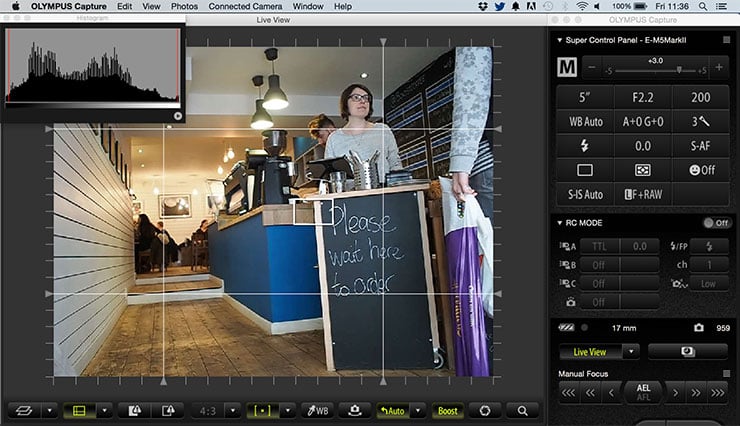 |
It’s possible to remote control the OMD EM5 Mark II either with a smartphone over Wifi – see later – or with a computer over USB. I’ve pictured the latter above, running the supplied Olympus Capture application on my MacBook Pro, where you can adjust a huge variety of settings, from exposure to focus or picture style. Interestingly when shooting tethered you can’t change the exposure mode without physically turning the dial on the camera, whereas on the smartphone app you can. That said, it’s not much of a hardship to turn the mode dial when the camera’s only at the end of a USB cable.
Olympus OMD EM5 Mark II viewfinder and screen
The OMD EM5 Mark II is equipped with a large and detailed electronic viewfinder and a fully-articulated 3in touch-screen. The viewfinder employs the same 2.36 million dot LCD panel of the EM1, sporting 1024×768 resolution, compared to the 1.44 million dot panel on the original EM5 which had a resolution of 800×600 pixels. That means a lot more fine detail can be seen during composition, but what makes a bigger difference is the size of the viewfinder image: 0.74x magnification on the EM5 Mark II makes for a considerably larger view than its predecessor and if you’re familiar with the EM5 you’ll find the difference in size and detail astonishing. In terms of scale it’s actually a little larger than a full-frame DSLR viewfinder, and this alone could tempt many EM5 owners into upgrading.
Compared to rivals, the OMD EM5 Mark II’s viewfinder, like the EM1 before it, is amongst the best around, especially as the native shape of Micro Four Thirds images fills the panel and avoids wasting space through letter-boxing. Personally-speaking I feel Fujifilm’s XT1 still enjoys the edge with an even larger viewfinder image that cleverly rotates the shooting information to remain upright when shooting in the tall / portrait orientation. But don’t let that takeaway from the EM5 II / EM1 viewfinder experience which remains highly immersive and pleasurable, and unlike the Fuji, remains cleaner in low light (by slowing its response). When switching from the original EM5 to the EM1, the viewfinder was one of the biggest upgrades for me, so to find the same panel on the Mark II is a delight.
The EM5 Mark II also upgrades its screen panel from the 610k OLED of the original EM5 to the same 1037k LCD of the EM1; the 3in size and 3:2 shape remain the same, so images shot in the native 4:3 aspect ratio are displayed with thin vertical bars down the left and right sides. The screen also remains touch-sensitive, allowing you to tap to reposition the AF area, tap to pull-focus while filming video, swipe through images in playback, drag various sliders (such as magnifying images or adjusting the AF area size) and touch your way round the Super Control Panel, albeit not go as far as tap the characters of your name in the copyright section – to be fair though, the on-screen alpha-numeric grid is too small to tap with much success.
The presence of a touch-screen shouldn’t be taken for granted. Canon and Nikon only offer touchscreens on a couple of select models, while Sony and Fujifilm don’t seem at all interested, leaving Samsung, Panasonic and Olympus flying the flag. I personally find them incredibly useful, especially for repositioning the AF area and pulling-focus while filming, and this functionality keeps drawing me back to Micro Four Thirds. With a screen that can now flip round to face the subject, Olympus has also implemented a Selfie Assist mode on the EM5 II which (if enabled) will present a simple on-screen button to activate a brief self-timer.
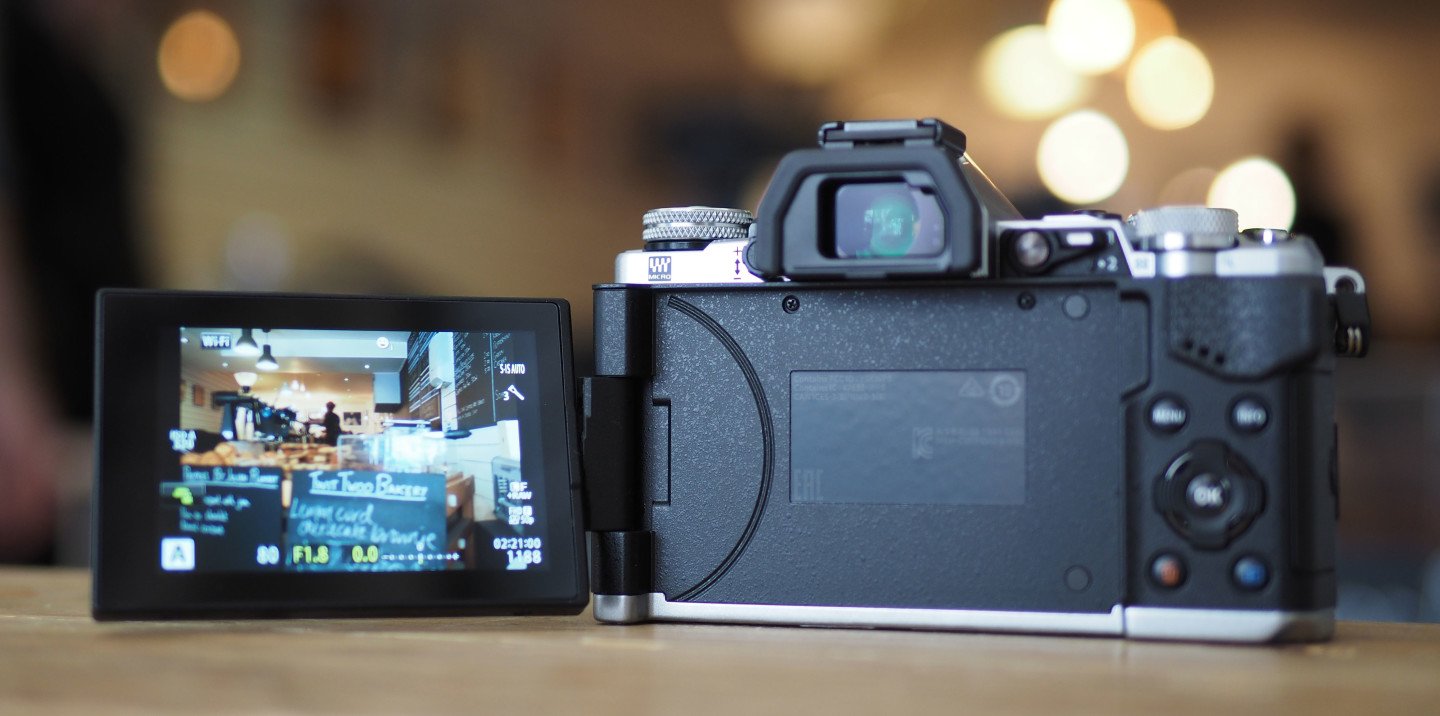
Hang on, fold round to face the subject? Yes, the EM5 Mark II becomes the first OMD to swap the traditional vertically-tilting platform for a side-hinged fully-articulated mount which allows the screen to be flipped and twisted to any position, including forward to the subject or back on itself for protection. This eliminates one of the benefits of higher-end Panasonic bodies over the OMD and is a boon for anyone who, like me, shoots tall / portrait aspect shots at high or low angles; after all a screen which tilts vertically only really helps when shooting in the landscape orientation. For example in the image below, I had the camera held high overhead to avoid converging vertical lines. If I had been composing in the landscape orientation, I would have been able to angle a basic vertically-tilting screen down to see what I was doing. But since I was composing in the portrait orientation, a vertically-tilting screen, such as that on the EM1, would have only angled left or right, rather than down. But the fully-articulated screen of the EM5 Mark II allowed me to twist it to the desired angle and capture the shot I was after. So for me the fully-articulated screen becomes one of the most important upgrades over any OMD to date. Coupled with the EM1’s viewfinder, it makes the EM5 Mark II my favourite OMD for composition. Oh yes, and this was captured handheld at half a second thanks to the amazing built-in stabilisation, more of which in a moment.
| |||
Olympus hasn’t skimped on the shooting information either. From the custom menus you can configure the camera to display a variety of different views for the viewfinder and screen, cycled using the INFO button. You can overlay a dual axis leveling gauge, a live histogram, blinking saturated areas, (using levels at the bottom and right side), along with the choice of five different alignment guides. It’s also possible to choose between a wealth of shooting information or a completely clean view.
During playback, you can cycle between a clean image, one with basic shooting information, another with a thumbnail to make room for RGB and brightness histograms along with more detailed shooting information, then one which displays a single large brightness histogram over the full image, another which reveals saturated shadows and highlights, and finally one which can show two different images simultaneously for side-by-side comparison. If you have a portrait shaped image, it’ll also rotate to fill the screen during playback if the camera is turned. Again you can customise which of the display views are shown from the custom menus.
In terms of the main menus, Olympus has opted for an almost identical approach to the EM5 and EM1 before it – so there’s five tabbed options on the left side, with their options displayed to the right. Four out of five of the tabs only need a single screen to display all their options, so there’s no scrolling to worry about. But the fifth option for the Custom Menu certainly does scroll. It gathers no fewer than 113 options (17 more than the EM1 and 27 more than the original EM5) into a bunch of lettered sub-categories, and even as a long term Olympus user, I still find the sheer degree of what you can customize overwhelming at times. The sub-categories at least let you quickly get to approximately where you need to be, and it seems churlish to complain about the number of things you can customize. The options are there if you want them, but equally you can stay clear if preferred! If you’re into customization though you’ll love what you can do with the EM5 II, and it’s one of the most flexible cameras around in this regard. I’ll mention some of the options throughout the review, and I strongly recommend any owner to invest some time in exploring the options available.
Olympus OMD EM5 Mark II lenses and stabilisation
The Olympus OMD EM5 Mark II employs a Micro Four Thirds sensor and lens mount which, like all OMD and PEN models before it (along with all Panasonic Lumix G cameras), results in a field reduction of two times relative to full-frame systems. So a 25mm lens delivers an equivalent field of view to 50mm on full-frame, and the effective depth of field compared to full-frame is also reduced by two times, so f1.4 will deliver a depth of field equivalent to f2.8 on full-frame.
The Micro Four Thirds mount gives the OMD EM5 Mark II access to the broadest and most established native lens catalogue of all the mirrorless camera systems. At the time of writing, Micro Four Thirds had over 40 lenses available from Panasonic and Olympus along with third parties including Sigma, Tamron, Samyang, Voigtlander and others. So while many rival mirror-less formats are struggling to offer even one lens in every category, Micro Four Thirds typically has two or more options available. Whether it’s Fisheye, ultra wide, fast aperture, macro, super-zoom or good old general-purpose, the Micro Four Thirds catalogue has it covered, and many of them are great quality too – find out more in my Micro Four Thirds lens guide.
Depending on region, you could find the EM5 Mark II available in a variety of lens kits, the most likely being the 14-42mm f3.5-5.6 pancake zoom, the 12-50mm f3.5-6.3, the 12-40mm f2.8 or the new 14-150mm f4-5.6 II; note if you want a weatherproof zoom to match the camera’s weatherproof body, you should go for the 12-50mm or 12-40mm. Or of course you could buy it body alone and choose your own lens from the wide catalogue – I like to shoot Micro Four Thirds with a selection of primes including the Olympus 17mm f1.8, Olympus 45mm f1.8 and Lumix 25mm f1.4. Here’s the coverage you can expect from the 12-40mm f2.8 PRO lens, which is a really classy option.
Olympus 12-40mm coverage wide | Olympus 12-40mm coverage tele | |
 |  | |
| 12-40mm at 12mm (24mm equivalent) | 12-40mm at 40mm (80mm equivalent) | |
While the 12-40mm is a great lens, I personally found it a little large on the EM5 Mark II. Instead I felt the body was physically best-matched with the smaller primes like the 17mm f1.8.
The EM5 Mark II, like all Olympus Micro Four Thirds bodies, features built-in image stabilisation which works with any lens you attach. Olympus has however enhanced the stabilisation on the Mark II, allowing it to claim five stops of compensation under CIPA conditions, compared to four on the EM1 or original EM5.
I was already very impressed with the stabilization on the EM1, so was very curious to discover if the Mark II had actually improved on it. I started with my usual test, shooting a sequence with and without stabilization at progressively slower shutter speeds. I decided to go with a wide-ish lens to see if I could handhold at a second or even slower with stabilization, so it was on with the 12-40mm at 12mm for a 24mm equivalent field of view. Traditional wisdom would suggest a shutter speed of 1/24 or faster to avoid wobbles when handgolding without stabilization. Three, four and five stops of compensation should let you handhold at 1/6, 1/3 or 1/1.5 respectively.
Olympus OMD EM5 Mark II with Olympus 12-40mm at 12mm Stabilisation off / on | ||
 |  | |
100% crop, 12mm, 1 sec, 200 ISO, IS off | 100% crop, 12mm, 1 sec, 200 ISO, IS on | |
On the conditions of the day I found I needed 1/12 or faster to handhold a steady shot without stabilization enabled. With stabilization enabled, I found I could easily handhold the same result at one second, corresponding to a little under four stops of compensation. You can see 100% crops from the unstabilised and stabilized one second exposures above.
But if I could successfully handhold at one second, how about longer exposures still? I dialed in two seconds and was surprised to find a respectable number of shake-free images; not all of them, but at least a 75% success rate. You can see an example at two seconds below, which represents a little under five stops of compensation on the conditions of the day.
| |||
I also tried four and even five second exposures, and while most were now shaky, there were a handful which were actually fine. But four to five stops of compensation was certainly attainable with the EM5 Mark II in my tests, confirming that it’s more effective than the models which came before it.
Indeed I’d say the EM5 Mark II’s stabilization is better than any optical system I’ve used, at least with lenses up to 300mm in equivalent focal length – the longest I had to hand. Tests and numbers aside, the thing which really surprised me was how different the EM5 Mark II felt when actually composing. I never felt the need to complain when framing-up with the EM1, but the EM5 Mark II really did deliver what looked and felt like a smoother, more ‘floaty’ experience. For someone like me who isn’t the steadiest photographer around, it’s a real and measurable benefit over the EM1.
Micro Four Thirds is often criticised for having one of the smaller sensors in the mirrorless World, but at lower ISOs it delivers great results. Now with around five stops of stabilised compensation available, the EM5 Mark II makes it possible to shoot handheld at low ISOs even under dim conditions and walk away with a decent result. Just look at that tunnel shot above for example, shot at the base sensitivity and even with the lens closed down a couple of stops. Of course if the subject is in motion, then it will blur at a slow shutter, but I found the ability to shoot city night scenes or dim interiors without relying on a tripod or high ISOs was very liberating.
I’m also delighted to report the full 5-axis stabilization system is also now available when shooting movies. I put this to the test by first making careful handheld pans, followed by more complex moves around the scene, before then walking purposefully and even running with the camera. Here’s one I filmed, walking up and down stairs with the camera, all handheld.
| |
|---|---|
| |
| |
In each situation the EM5 Mark II soaked-up the bumps and wobbles with ease. It really felt more like filming with a basic Steadicam, only without the bulk, complication, time and expense. Employ some careful technique and you may rarely if ever need to employ a balanced stabilizer. This makes filming with the EM5 Mark II swift and simple, whether you’re shooting holiday videos or small productions.
Olympus OMD EM5 Mark II autofocusing
Like its predecessor, the OMD EM5 Mark II exclusively employs a contrast-based AF system. Like other recent Micro Four Thirds cameras from both Olympus and Panasonic, the single AF performance is excellent with the camera snapping-onto subjects extremely quickly and confidently, even in low light or at large apertures with a very shallow depth of field. Indeed the EM5 Mark II delivers one of the most responsive AF experiences around in Single AF mode.
The EM5 Mark II’s contrast-based AF system, inherited from the EM1, can pick from a 9×9 array of 81 AF areas which cover most of the frame, an increased number over the 7×5 / 35 area system employed by the original EM5. Like the EM5 you can have the camera automatically choose the most appropriate AF area or pick it yourself either individually or from a zoned group.
As before you can adjust the size of a manually-selected AF area if desired, on the EM5 II between 5x, 7x, 10x or 14x. Like the EM1, you can also reduce the AF area size for pinpoint accuracy, although beware like the models before it the AF system can slow down with smaller AF areas.
Like all OMD cameras, you can alternatively tap the touchscreen to move the AF area wherever you like, again within a region that extends across the entire frame. I personally find this incredibly useful, although I don’t extend that embrace to include the touch-shutter option which also takes a photo with a tap. Still it’s there if you fancy it, and it does at least work well with the screen turned to face you for selfies. You can also adjust the AF area by hand by pressing the four cross keys – this feature is enabled straightaway, so there’s no need to go into a menu first, a bug-bear I have with many rival cameras.
A highlight of the Olympus contrast-based AF system is the face detection which goes beyond the usual framing of a human face to also lock-onto the eye and focus on that. As before you can have the camera go for the left eye, the right eye, or best of all, the nearest eye in the shot. And you know what? It really works. I use the nearest eye detection for all my people shots with Olympus cameras and even when using bright primes with a very shallow depth of field (such as the Nocticron 42.5mm f1.2), it almost always nails it; the only times it misses slightly are when the subject moves or blinks as you take the shot. It’s brilliant for taking shallow depth of field shots of impatient kids too.
So far so good, but as before the contrast-based system struggles when it comes to continuously tracking a subject approaching or receding at speed. To be fair, the EM5 Mark II proved to be fairly successful given subjects approaching at roughly 20 mph such as the vehicle below, but anything faster returned a decreasing hit rate. I should also add the continuous AF only worked at the slower of the two continuous shooting speeds, at 5fps. Put it this way, while the EM5 Mark II will track subjects in fairly leisurely motion, it’s not ideal for sports where the subject is moving towards or away from you quickly.
| Olympus OMD EM5 Mark II Continuous AF with Sequential L mode using 75mm f1.8 at f1.8 | ||||||
 |  |  |  | |||
| Full image above, 100% crop below | Full image above, 100% crop below | Full image above, 100% crop below | Full image above, 100% crop below | |||
 |  |  |  | |||
 |  |  |  | |||
| Full image above, 100% crop below | Full image above, 100% crop below | Full image above, 100% crop below | Full image above, 100% crop below | |||
 |  |  |  | |||
 |  |  |  | |||
| Full image above, 100% crop below | Full image above, 100% crop below | Full image above, 100% crop below | Full image above, 100% crop below | |||
 |  |  |  | |||
 |  |  |  | |||
| Full image above, 100% crop below | Full image above, 100% crop below | Full image above, 100% crop below | Full image above, 100% crop below | |||
 |  |  |  | |||
Other manufacturers, most notably Sony, have solved continuous autofocusing on mirrorless cameras by embedding phase detect AF points on the main imaging sensor. The model which does this better than any other in my tests so far is the Alpha A6000 (and the cheaper A5100 which followed it). The A6000 will even continuously autofocus at its top shooting speed of 11fps, which makes it my preferred choice if you’re into shooting fast action.
Olympus has tried embedding phase-detect AF points on the sensor, but so far only on the flagship OMD EM1 – and in my tests it only really made an impact when shooting with legacy Four Thirds lenses, which weren’t particularly quick to start with. This remains one of the major differentiators between the EM1 and EM5 Mark II, and if you have a collection of older Four Thirds lenses, the EM1 will be the preferred choice. A recent firmware update also allows the EM1 to support faster shooting speeds with continuous AF, although I’ve not put it to the test yet.
So returning to the EM5 Mark II, it’ll track slowish subjects, but anything approaching or receding at speed will almost certainly be out of its grasp. It’s a shame as the camera will fire-off bursts of frames very quickly, but if you’re into action and that action is moving quickly, then there’s better options out there.
It is however important to ask yourself just how often you’ll want to track fast subjects. Personally speaking I rarely shoot sports or wildlife, so it’s actually not an issue for me. But I certainly exploit the fast single AF of the Olympus cameras when shooting portraits, especially of my kids. Indeed as I noted earlier, the Olympus Single AF performance is up there with the very best, and if you’re shooting events, weddings, street or portraiture, you’ll really appreciate its speed and accuracy.
If you like to manually focus, or use lenses from other systems, the EM5 Mark II offers a number of tools to make your job easier. First is magnified assistance which can be set to kick-in as soon as you turn the manual focusing ring on native Olympus or Panasonic lenses; once in magnified view you can adjust the magnification to 5x, 7x, 10x or 14x, and also scroll around the frame if required.
The EM5 Mark II also inherits focus peaking from earlier models which surrounds the subject in focus with a highlight (in black or white on the EM5 II), allowing you to quickly identify whether the lens is focused correctly or not. It’s particularly helpful when also working in the magnified view, and it also works fine with third party lenses – I used it with my Samyang 7.5mm fisheye for example, where it provides a useful guide with subjects at very close range. Indeed this is another key feature to tempt EM5 owners into upgrading. Note when using non-native manual focus lenses, you’ll need to assign peaking to one of the function buttons as it won’t start automatically as it does with native ones.
The EM5 Mark II also offers AF / MF hybrid modes where the camera autofocuses with a half-press of the shutter, but allows you to make manual focusing adjustments (again with a magnified view and or peaking if enabled) with a turn of the focusing ring. I found the Single AF + MF mode worked well, using the AF to quickly find the subject before allowing you to fine-tune or confirm if necessary.
It all adds up to a satisfying manual focusing experience, and while peaking is still not available in different colours I am pleased to report Olympus now allows you to use it while filming video – a very useful upgrade over the EM1 which sadly disabled peaking while recording.
Olympus OMD EM5 Mark II exposure modes
The OMD EM5 Mark II offers nine exposure modes from its dial – the same as the EM1 and one more than the original EM5. There’s the usual PASM modes, along with separate positions for iAUTO, ART filters, Scene presets and Movies, although you can alternatively start filming video in any of the other modes. The new mode over the original EM5 is Photo Story, and I’ll come to it in just a moment.
The OMD EM5 Mark II offers the same mechanical shutter speed range as the EM1, from 60 seconds to 1/8000, the latter double that of the original EM5. 1/8000 is not only useful for freezing fast action, but also for allowing you to use smaller f-numbers (for a shallower depth of field) in bright conditions – I know I regularly bumped-up against the 1/4000 limit of the EM5 when shooting outside with bright primes (even after the addition of 100 ISO), but having a 1/8000 option gives you a useful extra stop of darkening and the chance to open the aperture by another stop without fitting ND filters.
Even better, the EM5 Mark II becomes the first OMD to be equipped with a 100% electronic shutter option which operates in complete silence and at speeds up to 1/16000, giving you another stop of exposure control over the mechanical shutter; the camera uses a 100% electronic shutter when you select Silent from the drive options. The option to shoot in true silence along with having access to even faster shutter speeds is a valuable addition the EM5 Mark II enjoys over its predecessors, including the flagship EM1. It’s also always been a feature that Panasonic has offered over Olympus, but now that differentiator has been eliminated. If you’re wondering why you wouldn’t use it all the time, it’s because electronic shutters can suffer from skewing artefacts when the subject is in fast motion, but if the subject is fairly still or you’re careful to only use it with faster shutter speeds, you’ll manage to avoid any unpleasant surprises.
Like the EM1 though, there’s also a variety of Anti Shock options which employ a delay and an electronic first-curtain to reduce the potential impact of the shutter causing unwanted vibrations. The EM5 Mark II also includes the zero second Anti Shock option introduced on an EM1 firmware update which again employs an electronic first-curtain, but without a delay. This is enabled by default on the EM5 Mark II for shutters below 1/320 and should prevent any unexpected and unwanted wobbles.
In terms of the actual mechanical shutter sound, the EM5 Mark II is noticeably quieter than the EM1 and EM5; indeed quite surprisingly so if you’re used to those models. Hold the camera at arm’s length in a romm with some ambient noise and you may hardly hear it at all. For me the quieter mechanical shutter and the option of a completely silent electronic shutter are two major benefits of the EM5 Mark II that are rarely discussed. They’re a highlight if you like to shoot discreetly, and are ideal in peaceful ceremonies.
Moving on, Auto Exposure Bracketing is available on the EM5 Mark II at two, three or five frames at 0.3, 0.7 or 1EV apart, or for seven frames at either 0.3 or 0.7EV apart. Matching the EM1, this is a nice broad and deep range for HDR enthusiasts, although unfortunately you still can’t trigger an entire multi-frame burst with a single press of the shutter release or self-timer. Instead you need to fire each exposure separately. On the upside the built-in Wifi means you can at least trigger each frame remotely using your smartphone rather than having to buy a cable release accessory.
Alternatively you could use the in-camera HDR mode. This offers seven different options, starting with two presets which capture four frames and assemble them in-camera with mild or strong contrast effects; these two modes record a single composite image, but they can include a RAW in addition to a JPEG if desired. The remaining five modes capture multiple frames, but require you to assemble them yourself later. You can choose three or five frames at 2EV or 3EV increments, or seven frames at 2EV only, and again you can record JPEG, RAW or both for each frame.
Regardless which of the seven options you choose though, the drive mode is fixed to Continuous High, forcing the camera to fire-them off in a quick burst. This is fine, but annoyingly it prevents you from implementing the self-timer to avoid camera shake, and it’ll ignore any Anti Shock delays too. Again though you can trigger the burst remotely using your smartphone, and in practice this can work well.
Olympus OMD EM5 Mark II HDR mode disabled | Olympus OMD EM5 Mark II HDR Mode 2 | |
 |  | |
 |  | |
| HDR disabled, 75mm (150mm equivalent) | HDR Mode 2, 75mm (150mm equivalent) | |
I should also add the EM5 Mark II offers ISO, White Balance, Flash Level and ART effect bracketing; the latter is a fun way to quickly try out all (or a selected bunch) of the ART filters if you can’t decide which you prefer – you can find out more about the ART filters later.
Sticking with the subject of multiple exposures, the EM5 Mark II also lets you combine two images on a single frame. You can also have the camera adjust the gain and show the first as a ghostly overlay as you line up the second. One file is recorded after the second exposure.
Moving on, the EM5 Mark II inherits the interval timer of the EM1, offering up to 999 frames at intervals from one second to a second shy of 25 (yes, 25) hours, and with an initial delay again up to a second short of 25 hours. You can choose whether to record just the images, or have the camera additionally create a movie from them. Unfortunately like the EM1, the movie encoding for timelapse captures is at a fixed frame rate of 10fps which doesn’t look particularly smooth during playback. Contrast this against the Panasonic Lumix G cameras which offer a variety of frame rates for in-camera timelapse movies up to 25 for a very smooth result, not to mention 4k encoding options too. Of course the EM5 Mark II still records the separate images regardless, so you could always just import them into software later and create a timelapse movie with the desired settings; but it remains a shame the camera can’t create a smoother result itself. Oh, one other quick tip: you’ll need to set the photo aspect ratio to 16:9 if you’d like the camera to subsequently encode a widescreen video.
| |
|---|---|
| |
| |
Like the EM1 and EM5 before it, the EM5 Mark II boasts a number of handy and unique options for long exposure fanatics. First is the ability to dial-in a shutter speed as long as 60 seconds, which is often long enough for basic long exposure work without the need for any accessories. Panasonic also offers this on its Lumix G cameras, and I find it invaluable. Here’s a shot I took simply by selecting a 60 second exposure time in Manual; I also used a Lee 3-stop ND filter and a hard grad filter.
| |||
Turn the exposure dial beyond 60 seconds in Manual mode and you’ll be offered Bulb followed by Live Time, and new to the EM5 Mark II, Live Comp; I’ll cover each in turn. Bulb works the same as a normal camera in that the shutter stays open for as long as you have the release held down. Live Time is more considerate for those without accessories as it opens the shutter with one press of the release and keeps it open until you press it again – so you don’t need to keep the button held down throughout the entire exposure.
Of course for the best results you’ll not want to actually touch the camera to start and stop a long exposure, but the EM5 Mark II cunningly lets you get around this without the need for additional accessories by first either implementing an Anti Shock delay or self-timer to start the exposure, coupled with a preset exposure length. Again, like the EM1 and EM5 before it, you can set the maximum exposure time to be 1, 2, 4, 8, 15, 20, 25 or 30 minutes, after which the camera will automatically end the exposure. This allows you to take very long exposures without the need for a cable release accessory.
What makes the Olympus cameras even more unique though are their Live Bulb and Live Time options which let you take regular peeks at the exposure on the screen as it builds-up to see how it’s getting on. This lets you stop the exposure early if it’s already perfect, or perhaps not going to work out. The interval between updates can be set to 0.5, 1, 2, 4, 8, 15, 30 or 60 seconds, and the maximum number of peeks depends on the ISO value: 9, 14, 19 or 24 times for ISOs of 1600, 800, 400 or Low respectively. Once you’ve used up your allocation of peeks, there’ll be no more, regardless of the exposure length. You can find the options to configure this in Custom section E.
During a long exposure, the actual exposure time is displayed like a digital stopwatch whether the Live update is enabled or not. If the Live update is enabled, then the screen will also show the image gradually appearing – like a developing photo – along with a brightness histogram that provides accurate feedback on the tonal range as it builds. The histogram updates its graph for every scheduled peek and it’s great fun to see it gradually move from left to right, filling the shadows, then the mid-tones and finally the highlights during a long exposure. The histogram is useful because the screen – especially when viewed in the typically dark conditions of a long exposure – is not always an accurate representation of the image. If you’re remotely controlling the camera over Wifi you can even view the mid-exposure peeks on your phone’s screen.
The ability to peek at a long exposure while it’s being recorded is innovative, fun and genuinely useful, but in my tests I found it did come at the cost of slightly increased noise levels. That said, the impact is quite minor and it’s also the type of noise that’s effectively reduced in post production if necessary.
When testing the EM5 Mark II though I was more concerned with the impact of disabling noise reduction for long exposures. When enabled, this captures a ‘dark-frame’ following the main exposure which can then be subtracted to eliminate, or at least greatly reduce, hot pixels. Like all long exposure noise reduction systems, the dark frame exposure must match the length of the original exposure, which is fine if you’re only talking a few seconds, but can become an issue for exposures of several minutes. The light can change quickly during dawn and dusk, so it’s frustrating to be kept waiting several minutes for recording a dark frame when you want to be taking more images. Likewise during fireworks events when you could be missing the big explosions as the dark frame is being recorded.
So that’s the dilemma: enable noise reduction for a nice clean image but risk losing the moment, or disable it for the best response but at the cost of quality. Clearly for long exposure fanatics, like myself, the question is how much of a compromise is involved when you disable noise reduction. When I tested the earlier OMD EM1, the answer was a significant compromise in quality. I found enabling noise reduction allowed me to capture nice, clean images at exposures up to two minutes, but disabling it resulted in a plague of hot pixels at exposures longer than 30 seconds. As such, I always enable noise reduction when shooting with the EM1, and just accept the frustration of waiting for the dark frame to be recorded.
The interesting thing though was the original EM5 didn’t seem to suffer as badly as the newer EM1. In my tests I found there was little between my images shot with or without NR, even for exposures up to two minutes in length. I still haven’t got to the bottom of this, but the fact is the EM5 was far preferable to the EM1 for long exposure work if you didn’t want to use noise reduction. So the question then is whether the EM5 Mark II inherits this capability of its predecessor. To find out I made two exposures lasting one minute of Brighton’s West Pier, one with NR enabled, and the other with NR disabled. Here’s 100% crops from shadowy regions of both images with links to the originals; the complete composition can be seen above.
Olympus OMD EM5 Mark II long exposure noise 60 secs at 100 ISO 100% crops from in-camera JPEG | ||
| 60 seconds with Noise Reduction enabled. Click for original | 60 seconds with Noise Reduction disabled. Click for original | |
I’ve had a good look at both images and even with the levels tweaked to lighten shadow detail, I can’t see a great difference between them. I can however tell you if this was the EM1, the version without noise reduction would be scattered with hot pixels.
So how long can you expose with the EM5 Mark II and still expect fairly clean images? I followed-up the shots above with two additional captures at four minutes and then eight minutes, both with noise reduction disabled. I also used Live Time with the maximum 24 peeks during the exposure, so they represent the worst-case scenario for potential noise.
Below is the eight minute capture (with a link to the four minute version in the caption), and if you look at the original images at 100% you’ll only see a couple of bright hot pixels (but don’t mistake the red one within the pier which is a buoy!). Look carefully, or boost the shadow areas, and a sprinkling of fainter marks emerge. It’s certainly not as clean as a camera with a bigger sensor, but remember this image has been ‘peeked-at’ 24 times during a fairly long exposure, so disabling this feature would present a slightly cleaner file. Also bear in mind this is a JPEG out of camera, so there’s potential for some more advanced clean-up on the RAW version in post afterwards. The bottom line is it’s still considerably superior to what you can achieve with the EM1 if you want to shoot without noise reduction, so for this kind of work the Mark II becomes my preferred choice of the two models.
| |||
Further extending the Live Time concept on the EM5 Mark II is the new Live Comp mode, which you’ll find after Bulb and Live Time in Manual. This addresses the problem of long exposure photography where one portion could become over-exposed before another has started to register, or even appeared at all. For example when shooting fireworks, you may want to have the background nicely exposed, but it could become over-saturated as you wait for the perfect explosion. The same thing can happen when you’re light-painting. Wouldn’t it be nice to effectively stop one part of the exposure while you wait to complete another part?
Photographers have traditionally done this by taking two or more exposures and compositing them later, but the new Live Comp mode attempts to do this entirely in-camera. First it exposes for the background, then it waits for any new light to appear in the composition. When new light does appear, such as a fireworks explosion or a new light painting, the camera will resume the exposure, but crucially only in the area where the new light is. This allows the frame to record the new area of light, without affecting the existing exposure underneath.
In practice the mode asks you to press the shutter release once for a reference shot, then again to begin the process. The camera then exposes for the desired shutter speed, showing you the image building on the screen. So far, similar like Live Time, except you’ll see the exposure halt on the screen when it reaches the desired brightness. Then even though the clock continues to tick, the camera won’t record anything more until new light appears in the composition. You can actually leave it monitoring the scene for up to three hours, safe in the knowledge it won’t become over-exposed, so long as the initial choice of shutter speed is correct.
Here’s an example of Live Comp used for light painting, which I took at an Olympus event; the artists were Zolaq. The mode was set to a five second cycle at f8 and 100 ISO, and the entire process took about five minutes to complete.
| |||
Switch the mode dial to SCN and you can choose from 24 different scene presets, three of which are designed for use with additional converter lenses. Of the more unusual options, Handheld Starlight shoots eight frames and combines them into one; I didn’t get a chance to try this in person, but hope to add an example in the future.
One of the other presets is the Panorama mode, but this remains a panorama-assistance option which simply displays guides to help you line up each frame; unfortunately they still need to be stitched in separate software afterwards. Why is it such a challenge for Olympus and Canon to offer stitched panoramas in-camera? Sony and Panasonic have offered it for ages, and it feels very old fashioned to be forced to complete the process on your computer afterwards.
Moving on, the ART position on the dial lets you apply a selection of 14 different filters, and while Olympus may have fallen behind on auto-panoramas, it was one of the first to really dive into in-camera effects. You can choose from Pop Art, Soft Focus, Pale Light and Colour, Light Tone, Grainy Film, Pin Hole, Diorama (Miniature), Cross Process, Gentle Sepia, Dramatic Tone, Key Line and Watercolour, and new to the Mark II, Vintage and Partial Colour. Or as mentioned earlier, opt for the ART Bracketing mode which takes shots with all of them, or a pre-selected bunch. Here’s some of the ART filters in action.
Olympus OMD EM5 Mark II ART Filter 1: Pop Art | Olympus OMD EM5 Mark II ART Filter 5: Grainy Film | |
 | 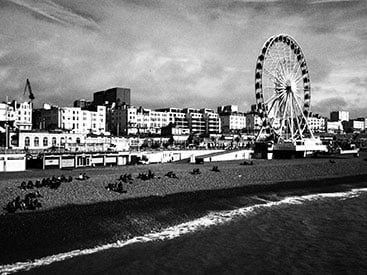 | |
Olympus OMD EM5 Mark II ART Filter 6: Pin Hole | Olympus OMD EM5 Mark II ART Filter 8: Cross Process | |
 |  | |
Olympus OMD EM5 Mark II ART Filter 10: Dramatic Tone | Olympus OMD EM5 Mark II ART Filter 13: Vintage | |
 |  | |
While going through the ART filters on-screen, you’re shown an example of the effect and pushing the right button expands a bunch of additional options. Yes, the effects are novelties, but the results to me look more mature and well thought out than much of the competition, a sign of Olympus’ experience in this regard. If you choose RAW+JPEG, the ART effect is also only applied to the JPEG file, leaving the RAW untouched as a backup or reference if desired. You can also record video with most of the effects applied, although the processing time incurred will reduce the frame rate. Here’s a video with the Diorama effect applied.
| |
|---|---|
| |
| |
Finally there’s the Photo Story mode which arranges between two and five photos into frames on a single image. A selection of presets let you choose the frame layout, the final aspect ratio of the image, along with the style of the borders and the art filters applied to the photos within. Once you’ve chosen the desired preset, one frame at a time becomes live, allowing you to compose each shot in turn before then letting the EM5 Mark II composite them into a single image.
It may sound a little tacky, but Photo Story, like the ART filters, is a fun way to present a story rather than a single image, and you can even create them on your phone or tablet using the free Olympus app. And if you’re shooting in RAW+ JPEG mode, the Photo Story effect is only applied to the JPEG, while the separate frames which make it up are saved as untouched RAW files, giving you the flexibility of using them without the effect later if desired. Here’s an example I took on Brighton’s Pier using the 45mm f1.8 lens.
| |||
Oh yes, I almost forgot: there’s also iAUTO for foolproof operation and while I can’t see many EM5 Mark II owners using it themselves, it can be useful when handing the camera over to someone else to take a photo with it. The iAUTO mode also offers a number of Live Guides which help you implement certain effects with on-screen controls.
Olympus has also been hard at work looking at clever ways of exploiting electronic composition to present in-camera corrections in real-time. All mirrorless owners are familiar with previewing white balance in real-time, but what about geometric corrections? A firmware update for the EM1 introduced Keystone Compensation which allows you to straighten converging lines either vertically or horizontally, all while you compose the shot. I’m pleased to report the EM5 Mark II inherits this capability, and here’s a handheld before and after comparison to show you how it works in practice. Inevitably there’s some cropping of the image and juggling of pixels, but it’s nice to be able to make these corrections in-camera as you compose.
Olympus OMD EM5 Mark II Keystone Compensation disabled | Olympus OMD EM5 Mark II Keystone Compensation enabled | |
 |  | |
| 45mm (90mm equivalent) | 45mm (90mm equivalent) | |
Here’s another example where I applied a little Keystone Compensation to straighten the verticals which due to the height of the camera were sloping a little inwards at the top.
| |||
Olympus OMD EM5 Mark II 40M High Res Shot
Arguably the most unique thing about the OMD EM5 Mark II is its new 40 Megapixel High Resolution Shot mode. This exploits the built-in image stabilization to shift the sensor’s position eight times by a tiny amount, before combining them all into a single, higher resolution image all in-camera.
Hasselblad offered something similar in the past to increase the recording resolution of its Medium Format bodies, but it’s the first time anything like this has been offered in a smaller system camera, and provides Micro Four Thirds with an important boost in detail beyond the native 16 Megapixels without compromising noise levels or dynamic range.
The 40M High Res Shot mode is tagged on the end of the Drive options, although also has a dedicated mention in the second Camera menu page with additional options. These include a chance to delay the shot which is critical if you want to avoid wobble; you can’t deploy the normal self-timer as it’s a separate option on the Drive menu. There’s the chance to record the final image as a single JPEG or a JPEG with a RAW file accompanied by a mysterious ORI file; the latter is actually the first frame in the sequence saved as a RAW file. RAW files currently require software from Olympus to process, although the company also has a Photoshop plugin. Note the file options for the Super High Res mode are independent of the quality set for single frame images, so just because you have RAW set for one doesn’t mean you’ll necessarily have RAW set for the other.
During the capture process, the sensor is repositioned eight times around a square. It takes the first shot, shifts right by half a pixel, takes the second, then right again by half a pixel for the third. Then up half a pixel for the fourth, up another half for the fifth, then left by half a pixel for the sixth, left half again for the seventh, then finally down by half a pixel for the eight and final shot. Another way of picturing it is the camera captures a photo at each corner of a square and an additional four in the middle of each side.
The theory is the four images in single pixel increments allow the camera to effectively capture red, green and blue for every pixel, greatly boosting colour resolution (and reducing colour moire), while the four half-pixel increments effectively quadruple the spatial detail.
With a native resolution of 16 Megapixels on the sensor, the 40M mode effectively creates a new RAW file with four times the total pixels: 64 Megapixels in all. But in tests, Olympus feels there’s not actually 64 Megapixels worth of real detail, so reduces it when generating in-camera JPEGs to 40 Megapixels. Normal single frame images from the EM5 Mark II measure 4608×3456 pixels, while 40M JPEGS created in-camera measure 7296×5472 pixels. Single frame RAW files typically weigh-in at about 15MB, while RAW files in the 40M mode weigh-in at around 100MB each, and are accompanied by an additional 15MB ORI file which, again, is the first frame in RAW format. So the two RAW files generated by the 40M mode are essentially eight times bigger than a single RAW frame as you might expect. In-camera JPEGs in the 40M mode typically measure around 18MB compared to around 8MB for a single frame.
The 40M mode switches the camera to an electronic shutter (for speed and stability) and fires its eight shots in just under a second. It then takes about two and a half seconds longer to generate the final composite file. Understandably the camera and subject should be kept still during the capture process. While it is possible to handhold the EM5 Mark II for one second during normal use, its stabilization is disabled during the 40M mode in order to shift the sensor – so hand-holding in the 40M mode is out of the question. Indeed the camera indicates if the camera isn’t sufficiently steady by blinking its 40M icon at you, and it’ll even warn you as you push the shutter release – which is why you should either deploy a delay from the menu or use remote control.
As for the subject, any motion will generate ghostly stitching errors. Cars, people or birds typically appear as eight faint shapes next to each other. The surface of rivers and the Sea looks unnatural with repeating waves rather than a smooth long exposure blur. Suffice it to say portraits are virtually impossible. As such the 40M mode is best-suited for compositions that remain static during the one second capture period: think still life, product photography, buildings, interiors, and of course image reproduction.
There are other caveats too. The maximum exposure (per frame) is eight seconds, which rules out serious long exposure photography. The highest sensitivity is 1600 ISO and the minimum aperture is f8. All three have been set to maximize quality and avoid noise or diffraction. Your optics are also important, with Olympus recommending its primes or pro zooms – so the basic kit zooms are unlikely to deliver sufficient resolution.
To be fair, Olympus has been playing down the feature, stating clearly that it is not for general use. The EM5 Mark II is not a 40 Megapixel camera. It is a 16 Megapixel camera with the chance to generate higher resolution images under the right conditions. But I think they’re being perhaps a little too cautious. I tried the mode in a variety of controlled and less controlled situations with results I think you’ll find impressive even with the limitations. So without further ado, here are 15 comparisons between the new 40M mode and conventional 16 Megapixel single frames.
| ||||||||||||
| ||||||||||||
| ||||||||||||
| ||||||||||||
| ||||||||||||
| ||||||||||||
| ||||||||||||
| ||||||||||||
| ||||||||||||
| ||||||||||||
| ||||||||||||
| ||||||||||||
| ||||||||||||
| ||||||||||||
| ||||||||||||
| ||||||||||||||||||
| ||||||||||||||||||
| ||||||||||||||||||
| ||||||||||||
| ||||||||||||
| ||||||||||||
| ||||||||||||||||||||||||
| ||||||||||||||||||||||||
| ||||||||||||||||||||||||
| ||||||||||||||||||||||||
| ||||||||||||||||||||||||
| ||||||||||||||||||||||||
| ||||||||||||
| ||||||||||||
| ||||||||||||
| ||||||||||||||||||
| ||||||||||||||||||
| ||||||||||||||||||
| ||||||||||||
| ||||||||||||
| ||||||||||||
| ||||||||||||
| ||||||||||||
| ||||||||||||
| ||||||||||||
| ||||||||||||
| ||||||||||||
| ||||||||||||||||||
| ||||||||||||||||||
|
Model: Radka Vachalova, Concept: Patrick Ludolph, Makeup and hair: Nadja Neu.
When Olympus first told me about the new 40M High Res Shot mode, it was careful to manage mine – and other photographer’s – expectations. They recognized and acknowledged the limitations, explaining it was really only for shooting static subjects, ideally in a studio environment, like product photography. Exteriors and portraits were not recommended, but of course that’s exactly what I went and shot with the EM5 Mark II, just to see for myself. If you’ve had a good look at the examples above, and downloaded a few of my original files for comparisons, I think you’d agree that it can actually be quite a powerful tool outside the studio.
It works best with tighter views which allow you to keep any pesky moving subjects out of the frame. I was impressed by the additional resolution and absence of colour moire in fine details on buildings and think I could certainly exploit it in my own travel photography. What does become apparent though is the impact of your technique and settings, not to mention the lenses in question. First you need top quality optics, but secondly you need to be shooting at apertures where diffraction won’t be an issue, and for Micro Four Thirds with an effective 64 Megapixel pixel-pitch, that means larger apertures / small f-numbers typically around f4. I had to close-down further for a sufficient depth of field in some of my shots above, but in turn missed out on some of the ultimate detail that the 40M mode may have captured under more sympathetic settings. This could prove problematic when shooting still life in the studio.
You’ll also have to watch out for moving subjects in compositions which you thought were static. Buildings may not move during the one second capture period, but they almost always have people or vehicles moving around them. Birds flying across a frame can be particularly problematic, which will make seaside photography almost impossible in this mode. Water too proved an issue, and unfortunately the longest exposure of eight seconds rules out sympathetic blurring through smoothing. That’s not to say I’d rule out shots including water in them. The 40MP mode considerately records the first image separately to the rest, allowing you in theory to take certain elements from it – such as water – and composite it with the rest later. You could of course make a separate long exposure altogether for the water and sky, and comp that with the high res version of the buildings. There are certainly workarounds.
I think it’s well worth exploring the possibilities too, as when the subject and settings align, the results can look great. Even when less than ideal settings or optics meant there wasn’t much additional spatial resolution, there was always the benefit of effectively having red, green and blue information for every pixel in the 16 Megapixel array.
Indeed I ended up being more impressed by the subsequent elimination of colour moire than chasing additional detail, and this made me wonder if a simpler implementation in the future could just shift the sensor four times in whole pixel increments rather than eight. After all this would halve the capture time, opening up further subjects possibilities. I do however believe there’s an existing patent on shifting a sensor four times to eliminate the negative impact of a colour filter array, so unless Olympus wants to license it (or is even given the option to), we’re stuck with the eight shot version and its additional attempt to boost resolution. So going forward I hope a sensor with faster readout can be developed, allowing the eight shots to be captured in less than one second. I also believe it could be possible to overlay the pixel shift with stabilization information to perform both simultaneously, perhaps allowing handheld capture in this mode. It’s an exciting technology that I hope to see developed further.
Ultimately I was impressed with the possibilities and once again see how it could work outside of the studio if you’re careful. It’s all about managing expectations, and I hope buyers of the EM5 Mark II fully understand what this mode can and can’t do. Remember this is not a 40 Megapixel camera. It is a 16 Megapixel camera that can generate a 40 Megapixel file by stitching multiple images into one.
Olympus OMD EM5 Mark II movie mode
In the past Olympus has never been strong with video features, but this is something the company wants to address with the EM5 Mark II. Previously you could only shoot 1080p at 30fps, using modest bit-rates of 20 or 17 Mbit/s. Now the EM5 Mark II offers the choice of 24, 25, 30, 50 or 60p frame rates (regardless of region). All frame rates can be encoded with IPB at up to 52Mbit/s, while the 24, 25 and 30p options can be alternatively encoded in All-intraframe at 77Mbit/s. There’s no 4k though, a limitation attributed to the processor rather than heat which bodes well for future models.
Focus peaking which previously disappeared when filming is now available, and the built-in stabilization is offered with the full 5-axes. Movie makers also benefit from the fully articulated screen, and if they’re using the optional mini-grip, they’ll have a headphone jack to complement the existing microphone input. Taking a leaf from Panasonic, there’s now a popout tray on-screen which offers silent touch control over aperture, shutter and ISO. Meanwhile the HDMI port outputs a clean uncompressed signal for external monitors and recorders (4:2:2 8-bit). The camera will also have a stab at continuous autofocusing while filming and you can tap the screen to pull-focus if desired, although while it is possible to remotely trigger a recording using the smartphone app over Wifi, it’s not possible to pull-focus with your phone’s screen.
| |
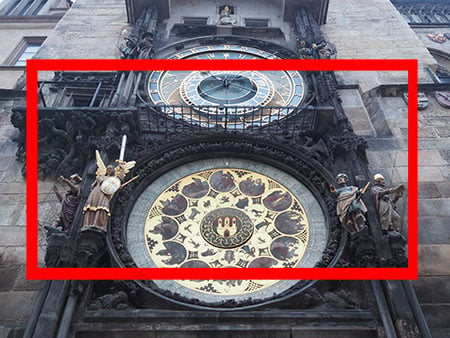 | |
When comparing stills with video filmed from a fixed tripod, it appears the EM5 Mark II makes a small crop to the coverage prior to scaling it down to a 1920×1080 frame. I’ve super-imposed a video grab over a normal photo opposite to illustrate this; the outer edge of the red frame indicates the 1080p video coverage.
From my own measurements, it looks like the initial crop is around 4000 pixels wide, from the original width of 4608 pixels. This is then down-sampled to 1920 pixels wide to generate Full HD. My guess-timate of 4000 pixels for the initial crop may not be 100% accurate, but I can tell you it’s definitely not as tight as 3840 pixels, which is a shame as while it would have involved a further reduction in the coverage, it would have allowed a very simple down-sample by exactly two times. I’m no camera engineer, but in my tests I’ve found cameras which employ an integer / whole number for down-sampling, like Canon’s EOS 5D Mark III or Panasonic’s Lumix GH4 (in its 4k mode), manage to avoid moire, whereas those which employ a fractional factor generally suffer from artefacts. And wouldn’t you know it, while the EM5 Mark II’s video quality is indeed improved from earlier Olympus models, some moire is visible in the clips below.
So now let’s check out a selection of sample movies I filmed with a final production EM5 Mark II.
| |
|---|---|
| |
| |
| |
|---|---|
| |
| |
| |
|---|---|
| |
| |
| |
|---|---|
| |
| |
| |
|---|---|
| |
| |
| |
|---|---|
| |
| |
| |
|---|---|
| |
| |
| |
|---|---|
| |
| |
| |
|---|---|
| |
| |
| |||||||
|---|---|---|---|---|---|---|---|
| |||||||
| |||||||
| Olympus OMD EM5 Mark II movie noise in low light / 1080 / 25p / 100% crops from composition above | |||||||
 |  |  |  | ||||
| 800 ISO (100% crop) | 1600 ISO (100% crop) | 3200 ISO (100% crop) | 6400 ISO (100% crop) | ||||
Olympus OMD EM5 Mark II ontinuous shooting
The Olympus OMD EM5 Mark II offers two continuous shooting speeds with the mechanical shutter: High, which shoots at 10fps, and Low, which shoots at 5fps. Olympus quotes a buffer of 16 RAW frames, or unlimited JPEGs at Large Normal size or lower.
To put the camera to the test I used a freshly-formatted UHS-1 card, set the shutter speed to 1/500, the sensitivity to 400 ISO and locked the focus. Starting with the High Speed, I fired-off 14 Large Normal JPEGs in 1.27 seconds for a speed of 11fps. Beyond this, the camera slowed fractionally to 8.3fps, but seemed happy to continue shooting at this speed while memory remained. Switching to RAW let me capture 12 frames in 1.16 seconds for a speed of 10.3fps, after which the rate fell dramtically to around 2.5fps while memory remained.
Setting the camera to Continuous Low, still with the mechanical shutter, let me capture 75 Large Normal JPEGs in 12.57 seconds for a speed of 6.6fps, and the camera seemed happy to keep shooting at this speed while memory remained. Switching the quality to RAW let me capture 15 frames in 2.37 seconds for a speed of 6.3fps, after which the rate dropped again to around 2.5fps.
The OMD EM5 Mark II also offers continuous shooting with the electronic shutter in complete silence. Set to Silent High, I fired-off 88 Large Normal JPEGs in 11.26 seconds, for a speed of 7.8fps. Remember shooting with an electronic shutter can incur rolling shutter artefacts which could skew the image for subjects in motion, or when panning quickly.
In practice the EM5 Mark II shoots at roughly the same speed as the flagship EM1, but there’s two differences. First, the buffer is larger on the EM1, allowing it to capture up to 50 RAW frames in a burst, not to mention larger bunches of JPEGs recorded with milder (Fine or SuperFine) compression before it stalls or slows. Secondly, a firmware update in March 2015 allowed the EM1 to continuously autofocus at its top speed, whereas the EM5 Mark II can only do this at the Lower speed of 5-6fps. I’ve not yet tested how well the EM1 can track at its top speed, but the buffer difference is significant and measurable. Since both models can fire-off bursts at such quick rates, you can burn through the buffer on the EM5 Mark II in a couple of seconds depending on the quality. But the EM1 lets you keep shooting for longer periods at the top speeds and best quality modes. I’ll update this and my EM1 review when I’ve had a chance to retest the continuous AF performance on the flagship model.
Olympus OMD EM5 Mark II Wifi
The OMD EM5 Mark II features built-in Wifi, a feature that was absent from the original model. The implementation on the Mark II is essentially the same as the EM1 before it and allows you to wirelessly transfer images and remote control the camera using a free app on iOS or Android smartphones, or tag photos with a GPS log, again made by the app on yuor phone.
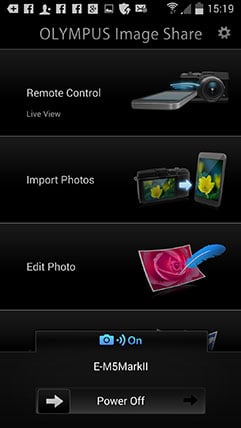 |  |
I regularly use Wifi to copy images onto my phone for quick and easy sharing, especially since I rarely feel the need to post-process them on a computer first. It was a feature I missed on the original EM5, so one that I’m very happy to find on the EM5 Mark II.
To get started, install the free Olympus Share app on your phone or tablet; it’s available for iOS or Android devices and I tested the latter on my Samsung Galaxy S4. Next tap the Wifi icon in the top right corner of the screen (you may need to press the info button to see it), then the EM5 Mark II will display a QR code on-screen.
If the camera and phone have not yet been paired, then simply start the Olympus app and point the phone’s camera at the camera’s screen to scan it – I was amazed how quickly this worked with the app getting the information it needed just as I began to point the phone at the QR code. From this point on the scanning shouldn’t be necessary. Starting the Olympus app will fire-up Wifi and look for the signal from a camera it’s already paired with and simply connect to it. I’d previously been impressed by the touch-pairing of NFC on Panasonic and Sony cameras, but this is as easy and possibly quicker too.
Once connected the app offers four main options: Remote Control, Import Photos, Edit Photo and Add Geotag. I’ll cover each in turn. Tapping Remote Control lets you see a live image from the camera and refocus it by tapping on your phone or tablet’s screen. Impressively you can remotely change the exposure mode between Program, Aperture Priority, Shutter Priority, Manual, iAUTO, ART and movie without touching the camera’s mode dial. Depending on the selected mode, you can then tap to adjust the shutter speed, aperture, exposure compensation, ISO and white balance, along with changing the drive mode, and of course triggering the exposure. If desired you can also dial the shutter speed in Manual all the way to Live Time and if previews are enabled on the camera you can view the peeking during the exposure along with the updated histogram on your handset’s screen.
New to the latest version of the app is the ability to configure a basic interval timer or trigger a movie recording. The interval timer is more like an advanced self-timer, taking no more than ten shots at intervals no greater than 12 seconds, but it’s still a handy update, and you can also configure it to capture bursts or movies instead if preferred. If you choose to record movies remotely with the camera you can’t touch the screen to reposition the AF area or pull-focus – something that is possible on Panasonic Lumix G cameras.
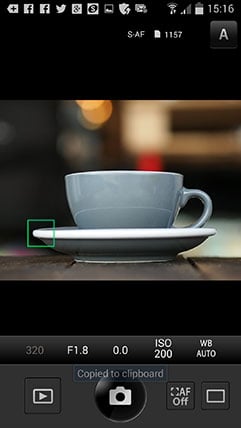 | 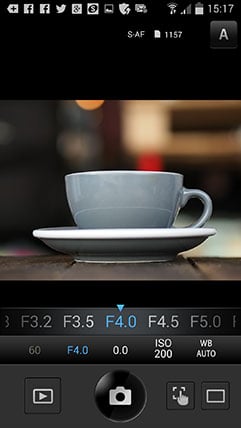 |  |
The second option on the app is to Import Photos and pressing it displays a thumbnail view of the card’s contents which you can scroll through. Tapping a photo displays it full-screen, after which you can pinch to zoom-in for a closer look, albeit not at the maximum resolution. If you like what you see you can save the image to your handset by tapping the floppy disk icon, or share it using the sharing icon alongside – of course once it’s saved onto your handset you can also share it later. In the separate settings page you can choose to import images for saving or sharing at 1024×768, 1600×1200, 1920×1440, 2048×1536 or their original resolution – JPEGs only though, not RAW files. It took about 12 seconds to copy an original JPEG measuring 6.6MB from a few inches away.
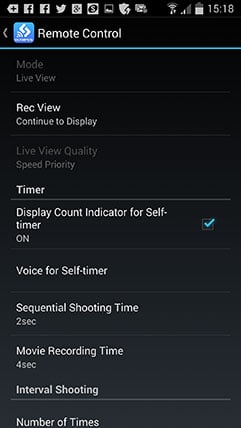 |  |  |
Choosing Edit Photo lets you perform a number of adjustments on images that have already been copied onto your handset. You can apply Art Filters, superimpose text, logos, even signatures written on your phone’s touchscreen, and play around with composite Photo Story arrangements.
Finally the Add Geotag option does what it says on the tin by tagging photos with positional information recorded by your phone. For this to work, you first need to switch on the Geotag feature from the app, and if desired, change the logging frequency from the default 60 seconds. After that the app will dutifully record your position at the preset intervals until you’re ready to sync them with the images on the camera.
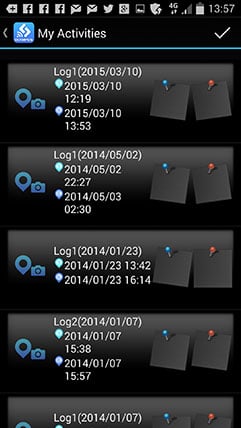 |  | 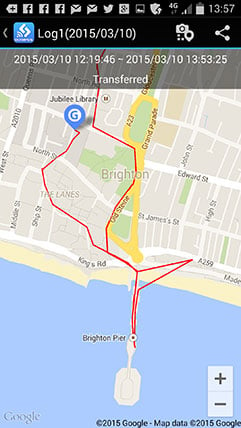 |
The actual tagging is a very easy process: if it’s enabled the app will actually offer to tag your photos as soon as the phone and camera are next connected over Wifi. The process is fairly quick too, and the app can additionally plot a log on a Google map, although you may need to disconnect from the camera to load the map details from the internet.
 |
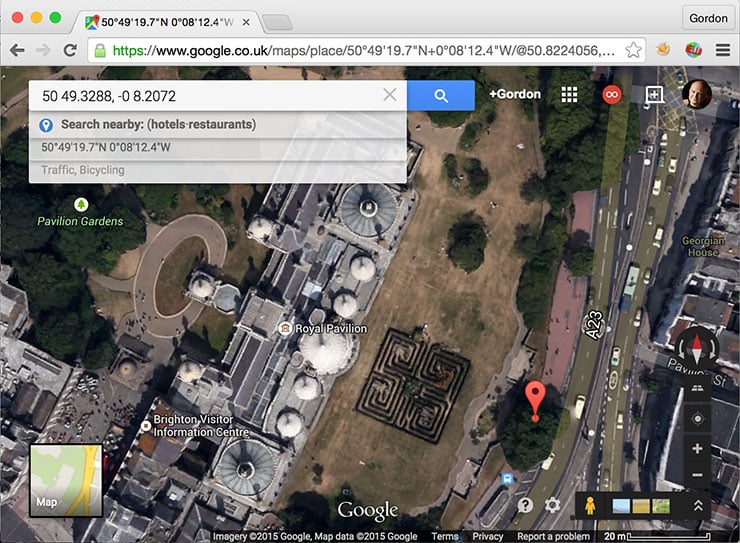 |
In the example above, my Galaxy S4 had a good lock on the GPS satellites and allowed the Olympus app to tag the photo with a very accurate position. But like any other camera which relies on a separate device for collecting positions, it’s at the mercy of that device. If the phone is buried away in a bag or pocket, the accuracy could suffer, and an altogether better solution is to have a device collecting positional information that’s out in the open as you take the photo – namely your camera. I do wish manufacturers would integrate GPS into more cameras, but if we do need to tag via a smartphone, the Olympus solution at least makes it as quick and painless as possible.
Indeed I was impressed by the overall implementation and functionality of the Olympus smartphone app – the remote control really is powerful and useful, and the only way I’d improve it would be to have a more advanced interval timer, touch-focusing during movies and an automatic push from the camera for those wanting to sync or backup images online as they take them. Ultimately though, the implementation is well thought-out and useful, making it a key upgrade for existing EM5 owners who’s only wireless option has been image transfer via an Eye-Fi card (although that does at least let you copy JPEGs and or RAW files to laptops).
Olympus OMD EM5 Mark II sensor and processing
The Olympus OMD EM5 Mark II is equipped with a 16 Megapixel sensor that’s described as being similar to the original EM5, although details of any differences are not published. The resolution’s certainly the same, as is the absence of an optical low pass filter and the continued absence of embedded phase-detect AF points.
So for yet another generation Olympus has stuck with 16 Megapixels, which continues to rank Micro Four Thirds amongst the lowest resolution of all the current system cameras. Is this a problem? Personally speaking I’m completely at peace with this resolution, having shot most of my personal photography with 16 Megapixel Micro Four Thirds bodies for over three years now. Not once have I wished for higher resolution files or had anyone commenting on their lack of detail – indeed most seem to notice the sharpness in the corners due to excellent optics before anything else. But at the same time I know it proves off-putting for owners of higher resolution models who are considering a switch. It may involve a reduction in ultimate resolution and equally implies this is as far as the format is going in this respect. It’s something you’ll have to decide for yourself, although again if it offers any reassurance, I find the combination of 16 Megapixels and the excellent Micro Four Thirds lens catalogue a very satisfactory combination. Indeed I typically resolve more detail with an OMD fitted with a decent lens than a 24 Megapixel APSC camera fitted with an average lens.
Olympus has at least tried to address the relatively modest resolution with the new 40MP High Res shot mode on the EM5 Mark II, which shifts the sensor eight times and stitches the resulting eight images into one high resolution file. I’ve tested this feature in great detail earlier on this page and when presented with a static subject and a sharp lens, the results can show a noticeable boost in detail. Should the subject move during the capture, there’s some undesirable stitching artefacts, but use it carefully and it can certainly give the EM5 Mark II a useful hike in effective resolution. For general-use though, the EM5 Mark II is a 16 Megapixel camera, so you have to decide for yourself if this is sufficient for your needs.
In terms of image quality options, the EM5 II lets you record JPEG files at one of four quality settings. The clever part is you can configure the quality settings of these four options from a choice of three resolutions (Large, Middle, Small) and four compression levels (Super Fine, Fine, Normal, Basic); so if you like, all four JPEG options could be at, say, the maximum resolution but with different compression levels, or you could go for different resolutions, but all with the mildest compression applied. You can even customise the resolution of the Middle and Small options, with the choice of four for the former and three for the latter. As I’ve said throughout, Olympus doesn’t skimp on the degree of customisation.
Suffice it to say you can also record RAW files with or without an accompany JPEG, although RAW files are always at the maximum resolution and there’s no compression options for them. Using the default settings, Large Fine JPEGs typically measure between 7 and 8MB each, while RAW files weigh-in at around 15MB each.
The native aspect ratio is 4:3, so squarer than the 3:2 shape of most rival formats. You can choose to record in 3:2, 16:9, 1:1 or 3:4 shapes if preferred, although all involve cropping the original image. I’m fond of the 4:3 shape as it’s a close match for the classic 10x8in print size, and also works very well when composing in the portrait orientation.
The Picture Mode menu applies the contrast, sharpness, saturation, gradation and any monochrome filters as a series of presets or custom options. I used the default Natural mode for most of my test shots and found the typical Olympus colour is alive and well – indeed and I found out-of-camera JPEGs from the EM5 Mark II to be extremely satisfying, so much so I rarely processed RAW files unless I wanted to change the white balance, significantly modify the exposure or achieve an unusual effect. The concept of relying on JPEGs may be abhorrent to some enthusiasts for whom RAW seems to be the only option, but Olympus processes them better than most, and if you opt for minimal compression the EM5 II, like its predecessors, simply records great looking images with little or no intervention. You can see a broad range of examples in my OMD EM5 II sample images page.
As with all Live View systems, any image parameters can be previewed immediately on-screen. In terms of White Balance there’s Auto, seven presets, four one-touch options and the ability to manually set the colour temperature from a scale of 2000-14000K. Highlights and shadows can be adjusted using a tone curve, and the Mark II also inherits the Colour Creator option first implemented on the EM1 which uses a cunning on-screen circular interface to adjust satursation and hue. Saturation is represented by a concentric ring which can grow or shrink in diameter, increasing or decreasing the saturation respectively, while hue is adjusted by rotating a marker around the ring’s circumference. It’s quick and fun to make these changes using the twin control dial system, and shows Olympus is thinking about different ways to present the usual adjustments. By default, you can access the tone curves and Colour Creator wheel from Function Button 2, turning the front dial while pushing it to switch between them.
Finally, the sensitivity is available between 200 and 25,600 ISO, with an additional Low option, equivalent to 100 ISO. While the base sensitivity remains 200 ISO – and that’s the best option to record the broadest dynamic range – I welcome the inclusion of a Low option that was missing on the original EM5 firmware. If you’re shooting under bright conditions and want to open the aperture or select slower shutters to blur motion, a lower sensitivity option is always helpful.
Right, that’s enough talk, it’s time to check out my results and comparisons. Check out my Olympus OMD EM5 II quality, Olympus OMD EM5 II noise, Olympus OMD EM5 II sample images or skip straight to my verdict!
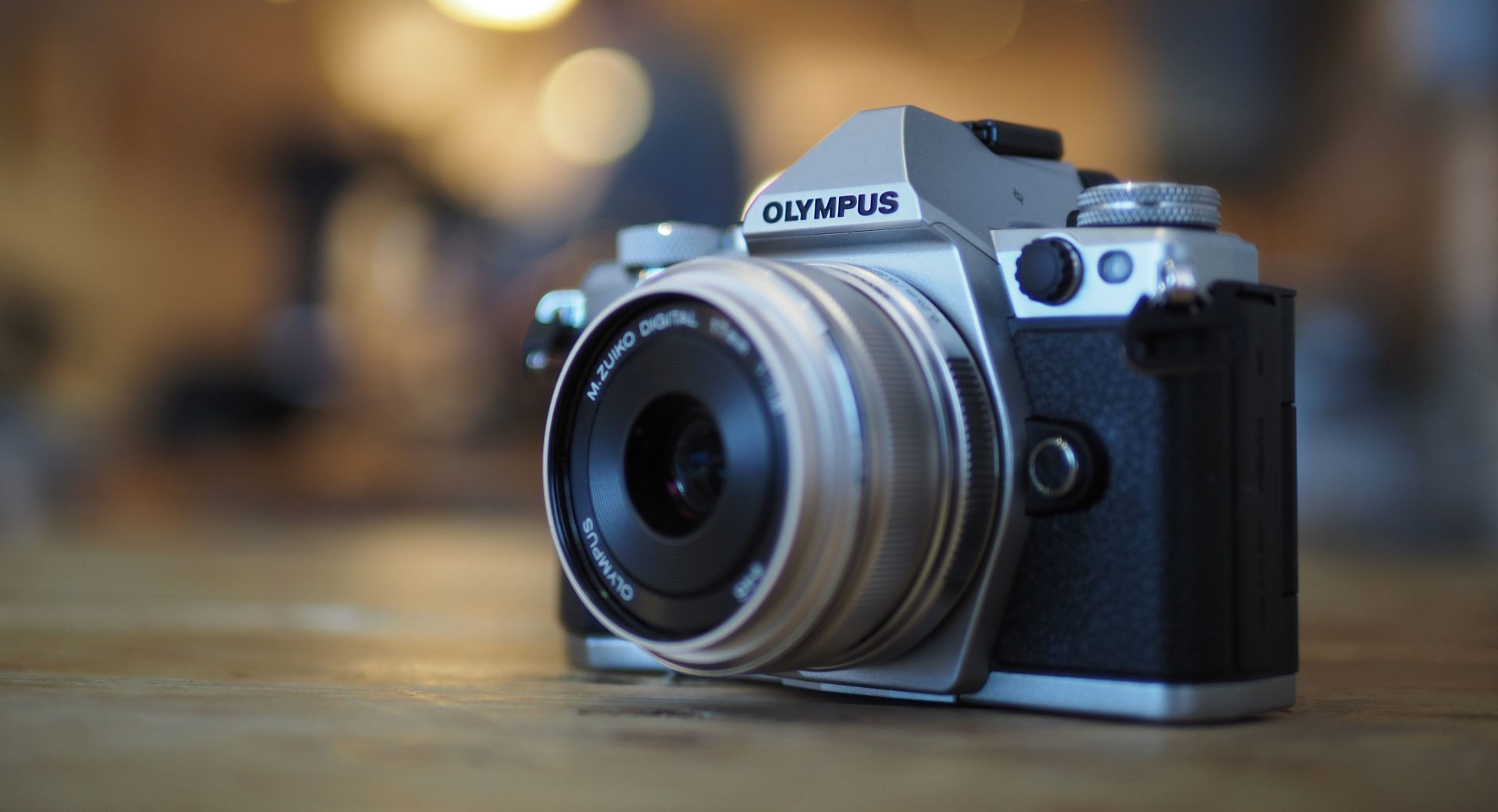
 The Olympus OMD EM5 Mark II is one of the most satisfying all-round cameras I’ve tested to date. It takes the charm of the original EM5, adds a bunch of features from the flagship EM1, complements them with a few new ones and even manages to improve some core capabilities too. It inherits the large viewfinder of the EM1, along with its built-in Wifi, PC Sync port and 1/8000 shutter. The control dials and buttons have been greatly improved, feeling much more tactile than the original EM5. It becomes the first OMD to feature a fully-articulated screen which nicely complements a greatly improved movie mode. Amazingly the already superb built-in stabilization is now even better, and a new High Res Shot mode exploits it to deliver composite images which, under ideal conditions, can contain 40 Megapixels of detail. The EM5 Mark II also has a quieter shutter than its predecessors, is the first OMD to boast a completely silent mode, and offers even more customization than the EM1. It's not perfect: there's better options for tracking subjects approaching or receding at speed, but for everything else, it's hard to beat for the money.
The Olympus OMD EM5 Mark II is one of the most satisfying all-round cameras I’ve tested to date. It takes the charm of the original EM5, adds a bunch of features from the flagship EM1, complements them with a few new ones and even manages to improve some core capabilities too. It inherits the large viewfinder of the EM1, along with its built-in Wifi, PC Sync port and 1/8000 shutter. The control dials and buttons have been greatly improved, feeling much more tactile than the original EM5. It becomes the first OMD to feature a fully-articulated screen which nicely complements a greatly improved movie mode. Amazingly the already superb built-in stabilization is now even better, and a new High Res Shot mode exploits it to deliver composite images which, under ideal conditions, can contain 40 Megapixels of detail. The EM5 Mark II also has a quieter shutter than its predecessors, is the first OMD to boast a completely silent mode, and offers even more customization than the EM1. It's not perfect: there's better options for tracking subjects approaching or receding at speed, but for everything else, it's hard to beat for the money.
